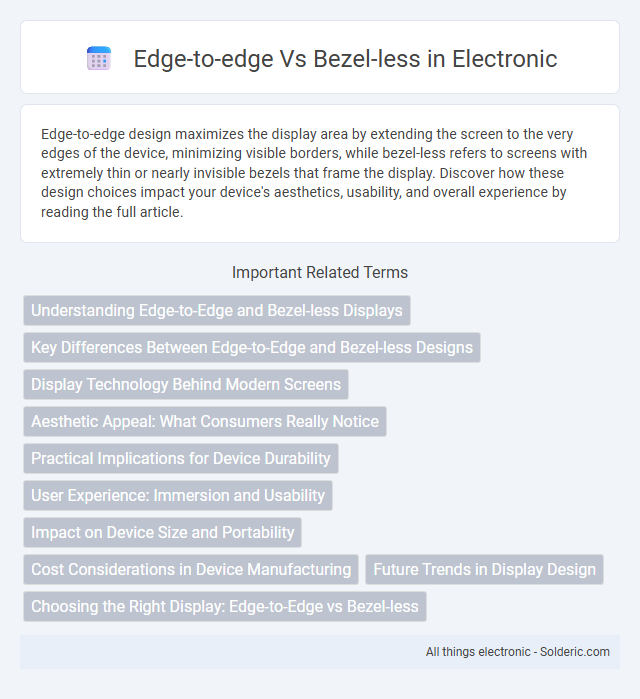Edge-to-edge design maximizes the display area by extending the screen to the very edges of the device, minimizing visible borders, while bezel-less refers to screens with extremely thin or nearly invisible bezels that frame the display. Discover how these design choices impact your device's aesthetics, usability, and overall experience by reading the full article.
Comparison Table
| Feature | Edge-to-Edge | Bezel-less |
|---|---|---|
| Definition | Display stretches seamlessly to the device's edges. | Minimal borders around the screen, but not fully edge-reaching. |
| Bezel Width | Almost zero, very thin or no visible bezel. | Thin bezels, slightly more visible than edge-to-edge. |
| Display Ratio | Maximized screen-to-body ratio, typically above 90%. | High screen-to-body ratio, generally 80-90%. |
| Design Impact | Sleek, modern, immersive visual experience. | Modern look but with subtle frame for durability. |
| Durability | Potentially less durable due to fragile edges. | More protection around screen edges. |
| Cost | Higher manufacturing cost due to complex design. | Moderate cost, easier to manufacture. |
| Usage | Premium smartphones, TVs, laptops prioritizing aesthetics. | Wide spread in mid to high-end devices balancing cost and design. |
Understanding Edge-to-Edge and Bezel-less Displays
Edge-to-edge displays maximize screen area by extending the glass to the device's edges, minimizing visible borders but often retaining a thin bezel underneath or around the sides. Bezel-less displays reduce or eliminate side and top bezels to create an immersive viewing experience, though some devices may still have slight bezels for structural support. Understanding the subtle differences in design and functionality between edge-to-edge and bezel-less screens enhances consumer awareness when selecting smartphones, tablets, or monitors.
Key Differences Between Edge-to-Edge and Bezel-less Designs
Edge-to-edge design features a screen that extends close to the device's edges, but still retains a thin bezel, whereas bezel-less design minimizes or completely eliminates the visible frame around the display for a seamless viewing experience. Key differences include the presence of a slight border in edge-to-edge screens, impacting durability and handling, while bezel-less devices maximize screen real estate and offer a more immersive visual effect. Your choice between these designs depends on preferences for aesthetics versus practical use and device protection.
Display Technology Behind Modern Screens
Edge-to-edge displays maximize screen real estate by extending the display panel close to the device's frame, often achieved through OLED or AMOLED technology that allows for flexible, thin panels with minimal borders. Bezel-less designs emphasize minimal or invisible bezels but may still include a thin frame, leveraging IPS LCD or newer mini-LED technology to reduce border size while maintaining structural integrity. Both technologies depend heavily on advancements in display manufacturing processes, pixel density optimization, and substrate flexibility to deliver immersive visual experiences on smartphones, tablets, and laptops.
Aesthetic Appeal: What Consumers Really Notice
Edge-to-edge displays maximize screen space by eliminating borders, creating a seamless and immersive viewing experience that significantly enhances your device's aesthetic appeal. Bezel-less designs, while similar, often retain minimal borders, which can subtly affect the perception of modernity and sleekness. Consumers tend to notice the uninterrupted display surface of true edge-to-edge screens, associating it with cutting-edge technology and premium quality.
Practical Implications for Device Durability
Edge-to-edge displays maximize screen size by extending the glass to the device's edges, which increases vulnerability to cracks and damage from drops due to minimal protective bezel. Bezel-less designs maintain a slim but noticeable frame around the screen, offering better structural integrity and shock absorption during impacts. Your choice between these designs affects device durability, with bezel-less models generally providing enhanced protection against everyday wear and accidental falls.
User Experience: Immersion and Usability
Edge-to-edge displays enhance immersion by minimizing frame distractions, allowing your content to seamlessly fill the screen for a more engaging visual experience. Bezel-less designs contribute to usability by maximizing screen real estate without compromising grip or accidental touches. Both technologies improve interaction and viewing comfort, but edge-to-edge offers a more striking effect for media consumption and gaming.
Impact on Device Size and Portability
Edge-to-edge displays maximize screen real estate by extending the display panel close to the device's edges, significantly reducing the bezel size and allowing larger screens in smaller form factors. Bezel-less designs minimize or eliminate the frame around the screen, enhancing portability by shrinking the overall device dimensions without compromising display size. Both designs improve compactness and user experience by enabling slimmer, lighter devices that are easier to carry while offering immersive viewing.
Cost Considerations in Device Manufacturing
Edge-to-edge displays typically incur higher manufacturing costs due to advanced OLED or flexible AMOLED panels and intricate assembly processes required for seamless integration. Bezel-less designs, while minimizing frame size, often rely on more conventional LCD technology, reducing expenses but sometimes compromising on true edge-to-edge screen real estate. Cost factors in device manufacturing also include increased precision in component placement and durability challenges associated with edge-to-edge displays, influencing final product pricing.
Future Trends in Display Design
Edge-to-edge and bezel-less display designs are driving future trends by maximizing screen real estate and enhancing immersive user experiences. Advances in flexible OLED technology and under-display cameras are enabling truly seamless displays without physical borders. This evolution supports innovations in smartphones, tablets, and wearable devices, promoting sleek aesthetics and improved functionality.
Choosing the Right Display: Edge-to-Edge vs Bezel-less
Edge-to-edge displays maximize screen size by extending the glass cover across the entire front surface, providing a sleek look but retaining a thin bezel beneath or around the edges. Bezel-less displays go a step further by minimizing or eliminating visible borders, creating an immersive viewing experience with near-borderless visuals. Selecting between edge-to-edge and bezel-less depends on design preference, device usage, and balancing aesthetics with durability and touch sensitivity.
Edge-to-edge vs Bezel-less Infographic

 solderic.com
solderic.com